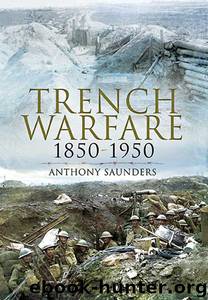Trench Warfare 1850-1950 by Anthony Saunders

Author:Anthony Saunders
Language: eng
Format: epub
Tags: HISTORY / Military / Strategy
ISBN: 9781781598764
Publisher: Pen and Sword
Published: 2010-08-18T16:00:00+00:00
CHAPTER 8
Grenade Warfare
A weapon closely associated with trench warfare at its most basic level is the hand grenade. During the First World War, and on the Western Front in particular, it had a huge impact on the way the fighting evolved. This was directly related to the grenades themselves, rather to than to mere numbers alone. While the grenades used in Manchuria during the Russo-Japanese War were in the tradition of grenades and grenade warfare as it had been practised for the previous 200 years, the grenades of the First World War were not only entirely different in engineering terms, but they took grenade fighting to an entirely new level. The tactical employment of grenades on the Western Front was derived from how they worked which, in turn, was derived from their engineering. This had a profound effect on trench warfare and, ultimately, contributed to the emergence of an entirely new mode of warfare during 1917 and 1918. The grenades of the First World War permitted the development of sophisticated tactical systems for their use which had not been possible hitherto.
While the German, French and British armies went to war in August 1914 equipped with some sort of grenade, no army had sufficient quantities to sustain the level of usage that developed during the autumn of 1914 and continued to rise throughout 1915. The demand for grenades rose at such a rate that all armies were forced to improvise in much the same way that the Russians and Japanese had extemporized grenades in Manchuria. From September 1914 onwards, Royal Engineers Field Companies improvised all manner of weapons and equipment for trench warfare to meet local demand, including grenades. In November, a large workshop facility was set up in the First Army area. This became known as the Béthune Bomb Factory and was initially run by the 3rd Company Bengal Sappers and Miners to meet the demands of the Indian Corps in the trenches at La Bassée. The Bengal Sappers and Miners had pre-war experience of improvising hand and rifle grenades from which they devised the so-called jam-tin and hairbrush grenades that were widely used by the BEF until the autumn of 1915. The French and the Germans extemporized similar grenades under similar circumstances, but not on the same scale as the British who were rather good at improvisation.
In May 1915, the Second Army Workshops was set up in an abandoned French technical school to devise and manufacture trench warfare stores, including grenades and mortars. The Bomb Factory and the Second Army Workshops both produced thousands of grenades a week as demand continued to rise during 1915. Before the war, there had been no demand for grenades in Britain and there was no intimation that a demand might arise. France was in much the same position, while Germany at least had grenades which could be mass produced. As far as Britain was concerned, a partial solution to the BEF’s lack of grenades was to re-engineer the jam-tin and hairbrush types for mass production; the result was the Nos 8 and 9 jam-tin patterns and the No.
Download
This site does not store any files on its server. We only index and link to content provided by other sites. Please contact the content providers to delete copyright contents if any and email us, we'll remove relevant links or contents immediately.
Shoot Sexy by Ryan Armbrust(17690)
Portrait Mastery in Black & White: Learn the Signature Style of a Legendary Photographer by Tim Kelly(16975)
Adobe Camera Raw For Digital Photographers Only by Rob Sheppard(16937)
Photographically Speaking: A Deeper Look at Creating Stronger Images (Eva Spring's Library) by David duChemin(16654)
Bombshells: Glamour Girls of a Lifetime by Sullivan Steve(14024)
Art Nude Photography Explained: How to Photograph and Understand Great Art Nude Images by Simon Walden(13006)
Perfect Rhythm by Jae(5361)
Pillow Thoughts by Courtney Peppernell(4247)
The Book of Joy by Dalai Lama(3947)
Good by S. Walden(3523)
The Pixar Touch by David A. Price(3392)
A Dictionary of Sociology by Unknown(3047)
Fantastic Beasts: The Crimes of Grindelwald by J. K. Rowling(3031)
Humans of New York by Brandon Stanton(2848)
Stacked Decks by The Rotenberg Collection(2846)
Read This If You Want to Take Great Photographs by Carroll Henry(2685)
On Photography by Susan Sontag(2608)
Insomniac City by Bill Hayes(2523)
Photographic Guide to the Birds of Indonesia by Strange Morten;(2512)
